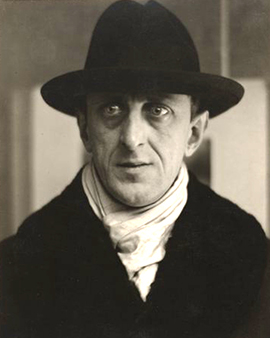Marsden Hartley was one of the most famous classical modern painters in the USA. He comes from a family of nine and grew up in the state of Maine. Early on he was enthusiastic about nature. Already as a teenager he helped a natural scientist friend of his to document native flora and fauna. He drew insects, butterflies and flowers. Through this he discovered his talent for painting, which from then on never left him. He moved to Cleveland and took art lessons at the Cleveland School of Arts. But he wanted more. He applied with his first paintings to the National Academy of Design in New York. His talent convinced the professors and he received a scholarship for a five-year study.
During his studies in New York he attended the master classes at William Merritt Chase. The American portrait and landscape painter had developed his own impressionistic style. As a professor at the National Academy he finally passed on his knowledge to young artists. During his studies, Hartley became interested in a certain painting technique called "Segantini Stitch". The technique was named after the Austrian painter Giovanni Segantini, who was known for his impressive open-air paintings. The special painting technique enabled the unbroken reproduction of light in paintings. The new technique increased the naturalistic effect of paintings.
After his studies Marsden met Alfred Stieglitz. The US-American was a successful photographer and gallery owner. As editor of the magazine Camera Work, he had managed to establish photography as an art form in America. In his famous gallery 291 he presented the world of photography and achieved great wealth. As a patron he henceforth promoted young artists. So Marsden Hartley also got the unique chance to show some of his paintings at an exhibition in Stieglitz Gallery 291. But that was not enough. Stieglitz financed a study trip to Europe for several years for the young painter from Maine. In Paris Marsden met other influential personalities such as Gertrude Stein, Arnold Rönnebeck and Karl von Freyburg. Marsden moved with Karl von Freyberg, with whom he had an intimate relationship, to his home town Berlin. Here his painting style changed due to the influence of the German avant-garde. He met Franz Marc and Wassily Kandinsky, members of the politically motivated art movement. Marsden's view of the world changed increasingly. His paintings became more abstract. Intensive color compositions were used. Due to the First World War, in which Hartley's great love Karl von Freyberg, who served as a soldier, died, he left Germany and returned to the USA. Marsden dealt with the tragic loss of his friend in a series of twelve paintings. Until his death, the painter Marsden Hartley lived in his home town. Here he again drew landscapes and genre paintings. However, the paintings differed from the landscape paintings of his younger years, for they were painted in expressive, contoured colors. His trademark!
×





.jpg)
.jpg)
.jpg)
.jpg)
.jpg)
.jpg)
.jpg)
.jpg)
.jpg)
.jpg)
_-_(MeisterDrucke-382979).jpg)
_-_(MeisterDrucke-382979).jpg)
_-_(MeisterDrucke-636166).jpg)
_-_(MeisterDrucke-636166).jpg)
.jpg)
.jpg)
.jpg)
.jpg)
.jpg)
.jpg)
 - (MeisterDrucke-573040).jpg)
 - (MeisterDrucke-573040).jpg)
.jpg)
.jpg)
.jpg)
.jpg)
.jpg)
.jpg)
.jpg)
.jpg)
.jpg)
.jpg)
.jpg)
.jpg)
.jpg)
.jpg)
.jpg)
.jpg)
.jpg)
.jpg)
.jpg)
.jpg)
_-_(MeisterDrucke-1454143).jpg)
_-_(MeisterDrucke-1454143).jpg)
_-_(MeisterDrucke-1426433).jpg)
_-_(MeisterDrucke-1426433).jpg)
.jpg)
.jpg)
 - (MeisterDrucke-587655).jpg)
 - (MeisterDrucke-587655).jpg)
.jpg)
.jpg)
.jpg)
.jpg)
_-_(MeisterDrucke-381555).jpg)
_-_(MeisterDrucke-381555).jpg)
.jpg)
.jpg)
.jpg)
.jpg)
.jpg)
.jpg)
.jpg)
.jpg)
.jpg)
.jpg)
.jpg)
.jpg)
_-_(MeisterDrucke-381556).jpg)
_-_(MeisterDrucke-381556).jpg)
_-_(MeisterDrucke-1533554).jpg)
_-_(MeisterDrucke-1533554).jpg)
 - (MeisterDrucke-572548).jpg)
 - (MeisterDrucke-572548).jpg)
.jpg)
.jpg)
.jpg)
.jpg)
.jpg)
.jpg)
.jpg)
.jpg)
.jpg)
.jpg)
_-_(MeisterDrucke-1427981).jpg)
_-_(MeisterDrucke-1427981).jpg)
.jpg)
.jpg)
.jpg)
.jpg)
.jpg)
.jpg)
.jpg)
.jpg)
.jpg)
.jpg)
.jpg)
.jpg)
_-_(MeisterDrucke-1403385).jpg)
_-_(MeisterDrucke-1403385).jpg)
.jpg)
.jpg)
.jpg)
.jpg)
.jpg)
.jpg)
.jpg)
.jpg)
.jpg)
.jpg)
.jpg)
.jpg)
.jpg)
.jpg)
.jpg)
.jpg)
.jpg)
.jpg)
.jpg)
.jpg)
.jpg)
.jpg)
.jpg)
.jpg)
.jpg)
.jpg)
_-_(MeisterDrucke-392631).jpg)
_-_(MeisterDrucke-392631).jpg)
.jpg)
.jpg)
 - (MeisterDrucke-563474).jpg)
 - (MeisterDrucke-563474).jpg)
.jpg)
.jpg)
_-_(MeisterDrucke-382980).jpg)
_-_(MeisterDrucke-382980).jpg)
.jpg)
.jpg)
_-_(MeisterDrucke-891518).jpg)
_-_(MeisterDrucke-891518).jpg)
.jpg)
.jpg)
_-_(MeisterDrucke-231433).jpg)
_-_(MeisterDrucke-231433).jpg)
_Autumn_2_1939-40_-_(MeisterDrucke-381558).jpg)
_Autumn_2_1939-40_-_(MeisterDrucke-381558).jpg)
.jpg)
.jpg)
.jpg)
.jpg)
_-_(MeisterDrucke-1352545).jpg)
_-_(MeisterDrucke-1352545).jpg)
 - (MeisterDrucke-572528).jpg)
 - (MeisterDrucke-572528).jpg)
.jpg)
.jpg)
.jpg)
.jpg)
.jpg)
.jpg)
.jpg)
.jpg)
.jpg)
.jpg)
.jpg)
.jpg)
.jpg)
.jpg)
.jpg)
.jpg)
.jpg)
.jpg)
.jpg)
.jpg)
.jpg)
.jpg)
.jpg)
.jpg)
.jpg)
.jpg)
.jpg)
.jpg)
.jpg)
.jpg)
.jpg)
.jpg)
.jpg)
.jpg)
.jpg)
.jpg)
.jpg)
.jpg)
.jpg)
.jpg)
.jpg)
.jpg)
_-_(MeisterDrucke-1448727).jpg)
_-_(MeisterDrucke-1448727).jpg)
.jpg)
.jpg)






